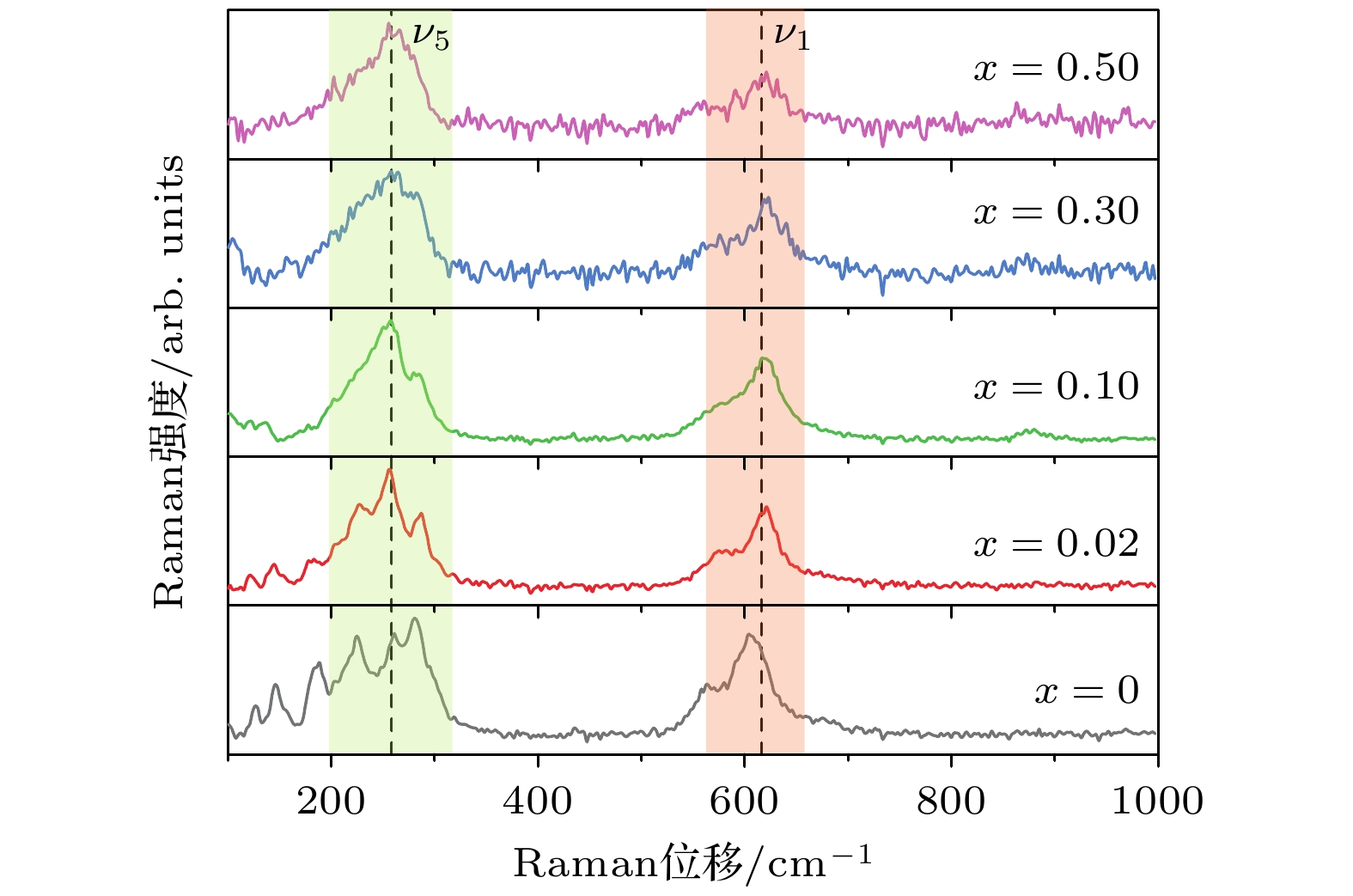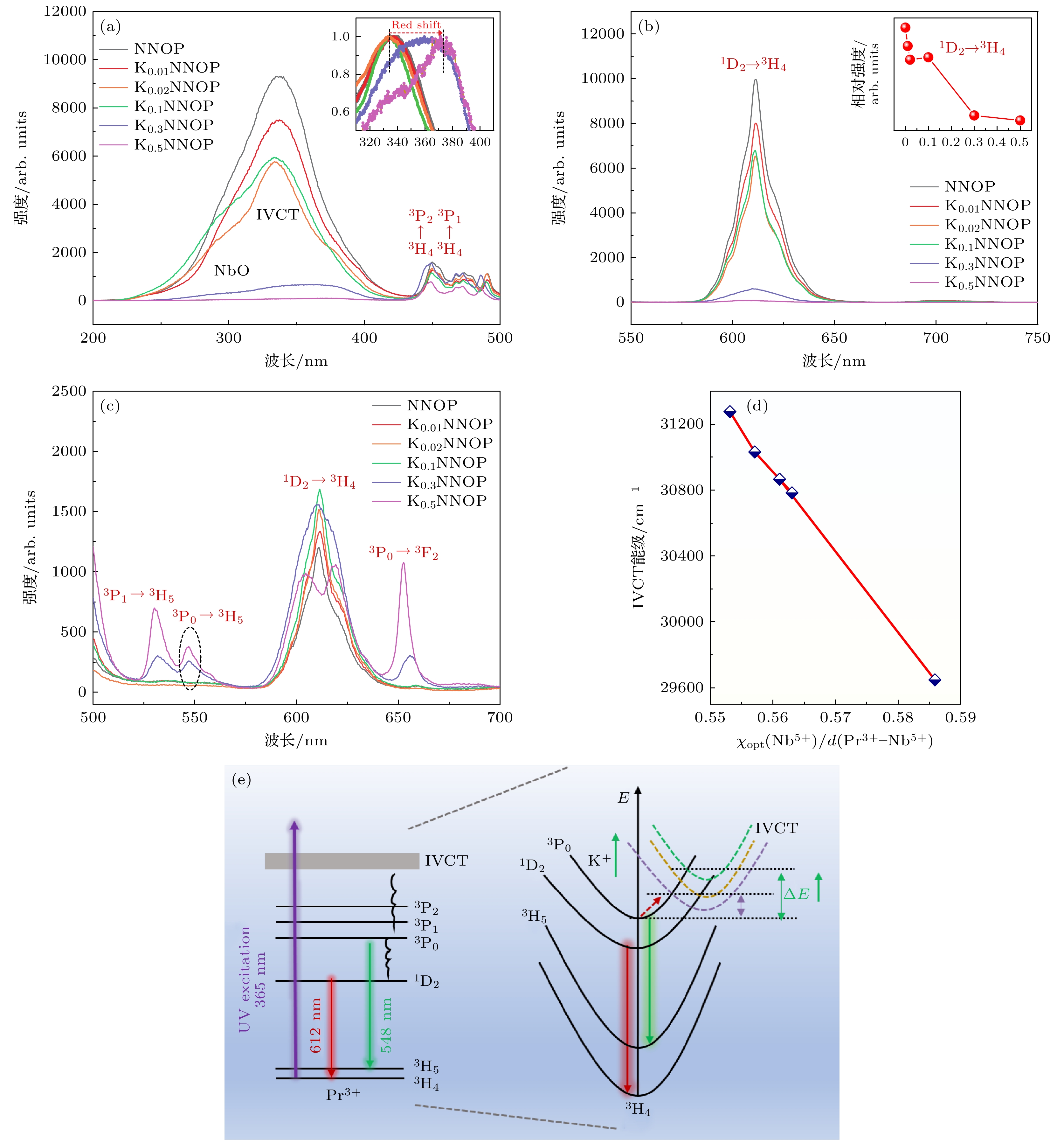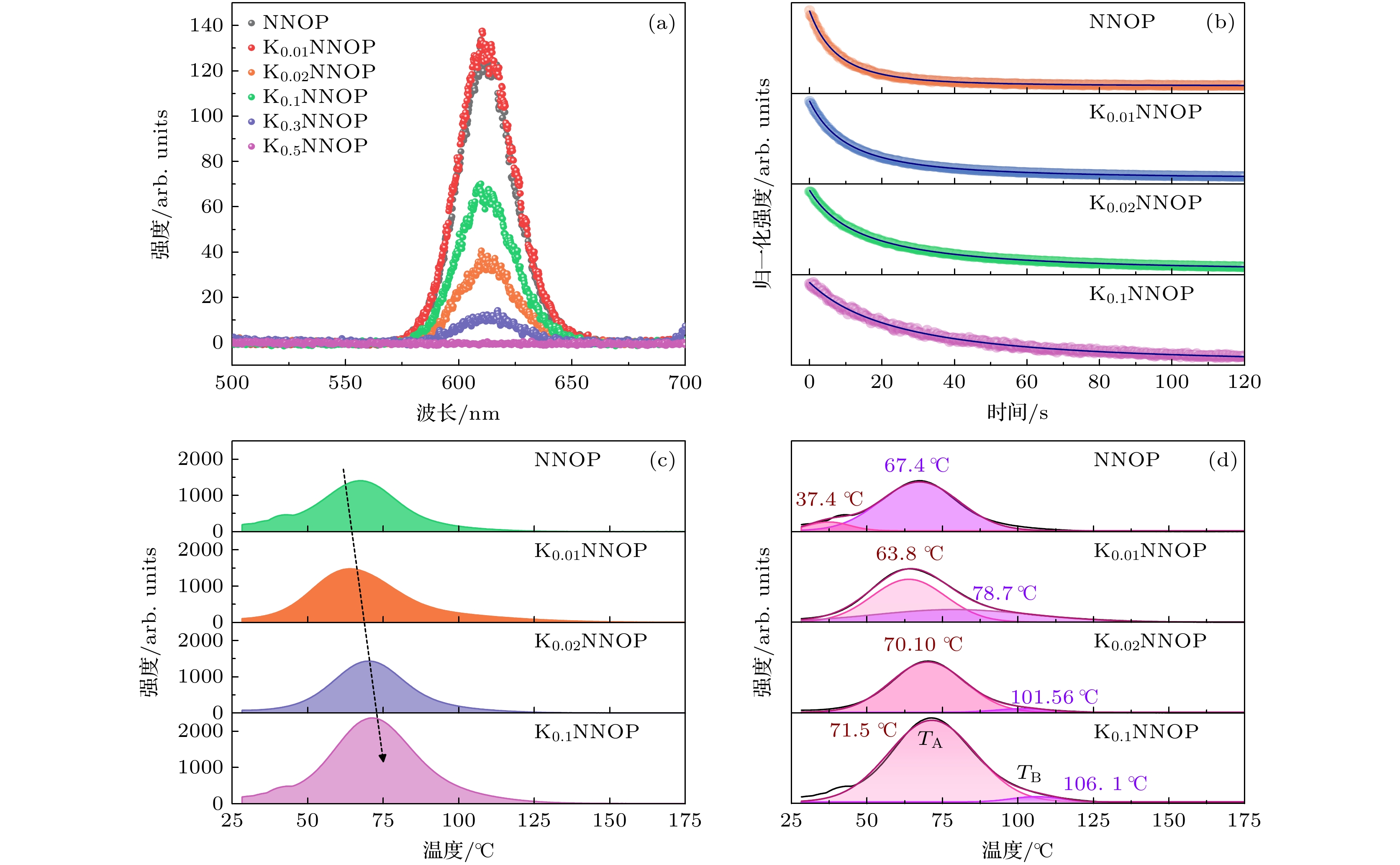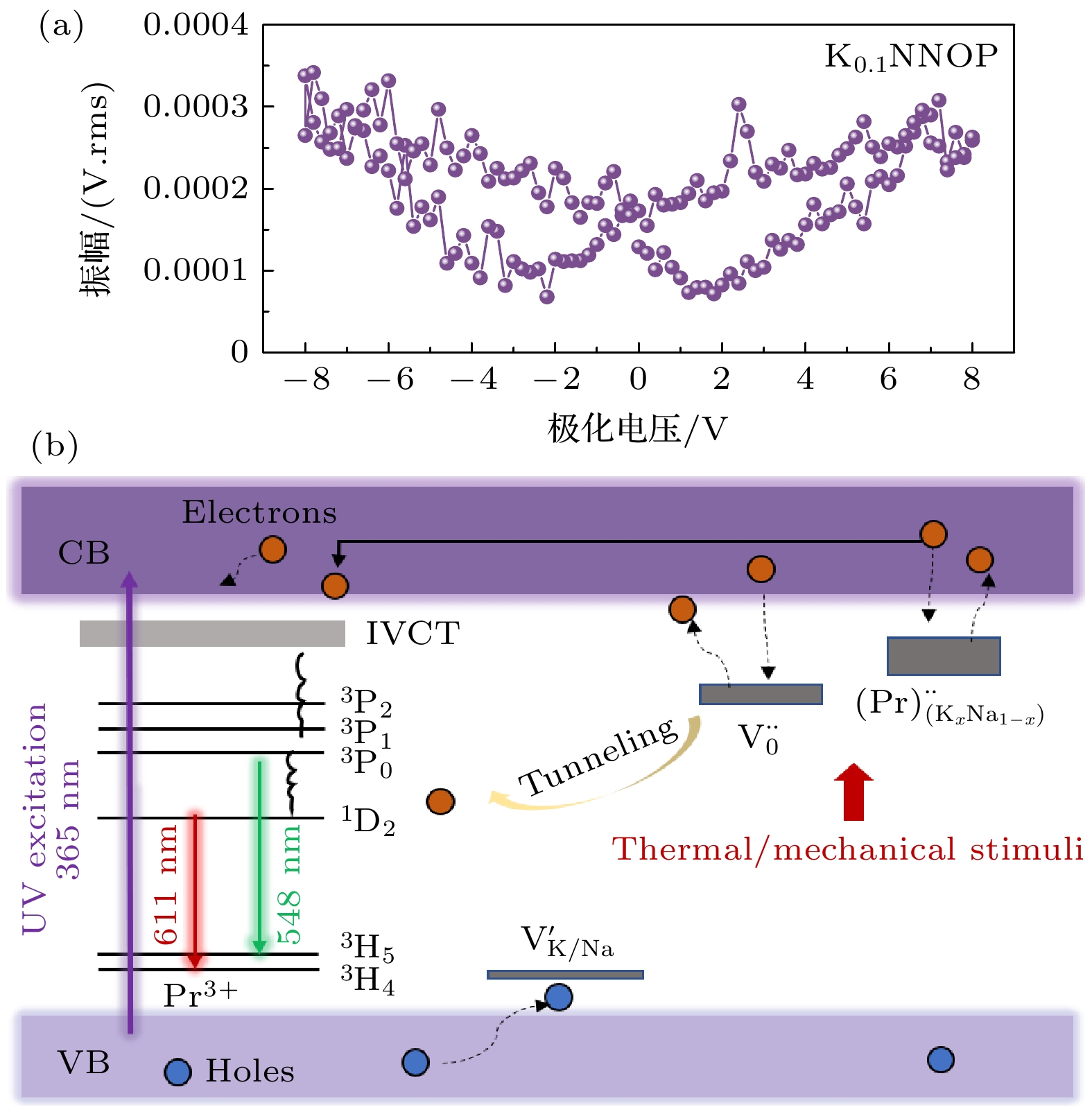-
应力发光材料具有应力-光转换特性, 能在机械应力下产生发光, 从而在光学信息显示方面具有很高的应用价值. 本文通过改变铁电基体KxNa1–xNbO3∶0.5%Pr3+ (KxNNOP)的K+/Na+比来调节材料的晶体结构和缺陷分布, 系统研究了K+含量对光致发光和应力发光性能的影响. 研究结果表明, K+含量的增加使晶体对称性提高, 导致KxNNOP样品的光致发光强度降低. 值得注意的是, 在450 nm的光激发下, 在K+含量较高的组分中出现了Pr3+电子3P1→3H5和3P0→3H5能级跃迁引起的发射峰, 这归因于Pr3+和Nb5+之间距离的变化导致Pr-O-Nb内价电子电荷转移态(IVCT)的能级位置不同. 在压缩应力下, KxNNOP (x = 0, 0.01, 0.02, 0.1) 组分展现出明亮的红色应力发光, 且应力发光强度随K+含量的增加而增大, 其中K0.1NNOP组分表现出最高的强度发射. 特别的是, 其应力发光行为具有可重复性和可恢复性的特征. 通过热释光曲线研究了KxNNOP样品中的陷阱能级, 揭示了K0.1NNOP中应力发光的增强可能与K+含量变化引起的陷阱密度和陷阱深度的差异有关. 基于这些结果, 建立了一个模型来阐述KxNNOP中可能的应力发光机理.
-
关键词:
- 应力发光 /
- 铁电 /
- KxNa1–xNbO3:Pr3+ /
- 缺陷分布 /
- 光致发光
Mechanoluminescent (ML) materials have mechanical-light conversion properties and can generate luminescence under mechanical stress, which makes the ML materials have high application value in optical information display. In this work, the crystal structure and defect distribution are adjusted by changing the K+/Na+ ratio of the ferroelectric matrix KxNa1–xNbO3∶0.5%Pr3+ (KxNNOP), and the effects of K+ content on the photoluminescence (PL) and ML properties are systematically investigated. The research results indicate that as the K+ content increases, the symmetry of the crystal is enhanced, leading the PL intensity of the KxNNOP samples to decrease. It is worth noting that the emission peaks caused by the 3P1→3H5 and 3P0→3H5 transition at the Pr3+ electron level appear in the PL spectra of the components with higher K+ content under the light excitation of 450 nm, which is attributed to the different energy level positions of the internal valence electron charge transfer states within Pr-O-Nb, caused by the change in the distance between Pr3+ and Nb5+. Under the compressive stress, the KxNNOP (x = 0, 0.01, 0.02, 0.1) components exhibit the bright red ML, and the ML intensity increases with the K+ content increasing. The K0.1NNOP component exhibits the highest ML intensity emission. In particular, the ML behavior has the characteristics of repeatability and recoverability. The trap energy levels in the KxNNOP samples are investigated by thermoluminescence curves, revealing that the enhancement of ML in K0.1NNOP may be related to the differences in trap density and trap depth, caused by changes in K+ content. Based on these results, a model is established to elucidate the possible ML mechanism in KxNNOP.-
Keywords:
- mechanoluminescence /
- ferroelectric /
- KxNa1–xNbO3:Pr3+ /
- defect distribution /
- photoluminescence
[1] Wang X, Zhang H, Yu R, Dong L, Peng D, Zhang A, Zhang Y, Liu H, Pan C, Wang Z L 2015 Adv. Mater. 27 2324
 Google Scholar
Google Scholar
[2] Jeong S M, Song S, Lee S K, Choi B 2013 Appl. Phys. Lett. 102 051110
 Google Scholar
Google Scholar
[3] Terasaki N, Yamada H, Xu C N 2013 Catal. Today. 201 203
 Google Scholar
Google Scholar
[4] Jeong S M, Song S, Lee S. K, Ha NY 2013 Adv. Mater. 25 6194
 Google Scholar
Google Scholar
[5] Jeong S M, Song S, Joo K I, Kim J, Hwang S H, Jeong J, Kim H 2014 Energy Environ. Sci. 7 3338
 Google Scholar
Google Scholar
[6] Peng D, Chen B, Wang F J 2015 ChemPlusChem. 80 1209
 Google Scholar
Google Scholar
[7] Chen B, Zhang X, Wang F J 2021 Acc. Mater. Res. 2 364
 Google Scholar
Google Scholar
[8] Xu C N, Watanabe T, Akiyama M, Zheng XG 1999 Appl. Phys. Lett. 74 2414
 Google Scholar
Google Scholar
[9] Xu C N, Watanabe T, Akiyama M, Zheng XG 1999 Appl. Phys. Lett. 74 1236
 Google Scholar
Google Scholar
[10] Wang X, Zhang H, Yu R, Dong L, Peng D, Zhang A, Wang Z L 2015 Advanced Materials 27 2324
[11] Chandra V, Chandra B, Jha P J 2013 Appl. Phys. Lett. 102 241105
 Google Scholar
Google Scholar
[12] Wang X, Yamada H, Xu C N. 2005 Appl. Phys. Lett. 86 022905
 Google Scholar
Google Scholar
[13] Zhang J C, Pan C, Zhu Y F, Zhao L Z, He H W, Liu X, Qiu J 2018 Adv. Mater. 30 1804644
 Google Scholar
Google Scholar
[14] Wei Y, Wu Z, Jia Y, Wu J, Shen Y, Luo H 2014 Appl. Phys. Lett. 105 042902
 Google Scholar
Google Scholar
[15] Egerton L, Dillon D M 1959 J. Am. Ceram. 42 438
 Google Scholar
Google Scholar
[16] Shirane G, Newnham R, Pepinsky R 1954 Phys. Rev. 96 581
 Google Scholar
Google Scholar
[17] Du H, Li Z, Tang F, Qu S, Pei Z, Zhou W J 2006 Mater. Sci. Eng. , B 131 83
 Google Scholar
Google Scholar
[18] Fan X H, Zhang J C, Zhang M, Pan C, Yan X, Han W P, Zhang H D, Long Y Z, Wang X J 2017 Opt. Express 25 14238
 Google Scholar
Google Scholar
[19] Zhang J C, Fan X H, Yan X, Xia F, Kong W, Long Y Z, Wang X J 2018 Acta Mater. 152 148
[20] Feng A, Smet P F 2018 Materials 11 484
 Google Scholar
Google Scholar
[21] Wang F, Liu X 2009 Chem. Soc. Rev. 38 976
 Google Scholar
Google Scholar
[22] Tennery V J, Hang K W 1968 J. Appl. Phy. 39 4749
 Google Scholar
Google Scholar
[23] Wells M, Megaw H D 1961 Proc. Phys. Soc. 78 1258
 Google Scholar
Google Scholar
[24] Zhang Q, Luo L, Gong J, Du P, Li W P, Yuan G L 2020 J. Eur. 40 3946
[25] Wang J, Luo L J 2018 J. Am. Ceram. Soc. 101 400
 Google Scholar
Google Scholar
[26] Kakimoto K I, Sumi T, Kagomiya I 2010 Jpn J. Appl. Phys. 49 09MD10
 Google Scholar
Google Scholar
[27] Chen T, Liang R, Li Y, Zhou Z, Dong X J 2017 J. Am. Ceram. Soc. 100 1065
 Google Scholar
Google Scholar
[28] Pinel E, Boutinaud P, Mahiou R J 2004 J. Alloys Compd. 380 225
 Google Scholar
Google Scholar
[29] Dorenbos P 2017 Opt. Mater. 69 8
 Google Scholar
Google Scholar
[30] Barandiarán Z, Meijerink A, Seijo L J 2015 Phys. Chem. Chem. Phys. 17 19874
 Google Scholar
Google Scholar
[31] Sun H, Zhang Q, Wang X, Bulin C 2015 J. Am. Ceram. Soc. 98 601
 Google Scholar
Google Scholar
[32] Zhang Q, Sun H, Zhang Y 2014 Jo. Am. Ceram. Soc. 97 868
 Google Scholar
Google Scholar
[33] Newman D J, Ng B 2000 Crystal Field Handbook (Cambridge: Cambridge University Press)
[34] Diallo P, Boutinaud P, Mahiou R, Cousseins J 1997 Phys. Status Solidi A 160 255
 Google Scholar
Google Scholar
[35] Li K, Xue D 2006 J. Phys. Chem. A 110 11332
 Google Scholar
Google Scholar
[36] Lecointre A, Bessière A, Bos A, Dorenbos P, Viana B, Jacquart S 2011 J. Phys. Chem. C 115 4217
 Google Scholar
Google Scholar
[37] Maldiney T, Lecointre A, Viana B, Bessière A, Bessodes M, Gourier D, Richard C, Scherman D 2011 J. Am. Chem. Soc. 133 11810
 Google Scholar
Google Scholar
[38] Van den eeckhout K, Bos A J, Poelman D, Smet P F 2013 Phys. Rev. B 87 045126
 Google Scholar
Google Scholar
[39] Shalgaonkar C, Narlikar A 1972 J. Mater. Sci. 7 1465
 Google Scholar
Google Scholar
[40] Sakai R, Katsumata T, Komuro S, Morikawa T 1999 J. Lumin. 85 149
 Google Scholar
Google Scholar
[41] Kang F, Yang X, Peng M, Wondraczek L, Ma Z, Zhang Q, Qiu J 2014 J. Phys. Chem. C 118 7515
 Google Scholar
Google Scholar
[42] Kang F, Zhang H, Wondraczek L, Yang X, Zhang Y, Lei D Y, Peng M 2016 Chem. Mater. 28 2692
[43] Gao Y, Huang F, Lin H, Zhou J, Xu J, Wang Y 2016 Adv. Funct. Mater. 26 3139
 Google Scholar
Google Scholar
[44] Akiyama M, Xu C N, Matsui H, Nonaka K, Watanabe T 1999 Appl. Phys. Lett. 75 2548
 Google Scholar
Google Scholar
[45] Matsui H, Xu C N, Akiyama M, Watanabe T 2000 Jpn. J. Appl. Phys. 39 6582
 Google Scholar
Google Scholar
[46] Zhang H, Yamada H, Terasaki N, Xu C N 2007 Appl. Phys. Lett. 91 081905
 Google Scholar
Google Scholar
[47] Fu X, Zheng S, Shi J, Zhang H J 2017 J. Lumin. 192 117
 Google Scholar
Google Scholar
[48] Shigemi A, Wada T 2004 Jpn. J. Appl. Phys. 43 6793
 Google Scholar
Google Scholar
[49] Wu X, Lin J, Xu Z, Zhao C, Lin C, Wang H, Zhai J 2021 Laser Photonics Rev. 15 2100211
 Google Scholar
Google Scholar
[50] Boutinaud P, Sarakha L, Mahiou R 2008 Phys. Condens. Matter 21 025901
 Google Scholar
Google Scholar
[51] Xie T, Guo H, Zhang J, He Y, Lin H, Chen G, Zheng Z 2016 J Lumine. 170 150
 Google Scholar
Google Scholar
[52] Zhang J C, Long Y Z, Yan X, Wang X, Wang F 2016 Chem. Mater. 28 4052
 Google Scholar
Google Scholar
[53] Chandra B P, Chandra V K, Jha P 2015 Phys. B: Condens. Matter 461 38
 Google Scholar
Google Scholar
-
图 2 (a) KxNNOP 样品的 XRD图谱; (b) 2θ在44º—48º范围内的放大图; (c) NNOP, (d) K0.5NNOP 样品的 Rietveld结构精修图; (e) 晶格常数随x的变化
Fig. 2. (a) XRD patterns of KxNNOP samples; (b) magnified view of 2θ in the range 44º–48º; rietveld structural refinement plot of (c) NNOP, (d) K0.5NNOP sample; (e) change of lattice constants with x.
图 4 (a) KxNNOP样品的PLE (λem = 612 nm)光谱, 插图是310—410 nm范围内放大归一化的 PLE光谱; (b) KxNNOP样品的PL (λex = 335 nm)光谱, 插图为1D2→3H4发射峰的相对强度与K+含量x的关系; (c) PL (λex = 450 nm) 光谱; (d) KxNNOP样品中的IVCT能级高度与
$ {\mathrm{\chi }}_{\mathrm{o}\mathrm{p}\mathrm{t}}\left({\mathrm{N}\mathrm{b}}^{5+}\right) $ /$d({\mathrm{P}\mathrm{r}}^{3+}\text{-}{\mathrm{N}\mathrm{b}}^{5+})$ 变化关系; (e) 能级位置坐标图, 其中ΔE 是从3P0能级和 IVCT 能级的交叉处到3P0 能级底部之间的距离Fig. 4. (a) PLE (λem = 612 nm) spectra of KxNNOP samples, the inset is the magnified normalized PLE spectrum in the 310-410 nm range; (b) PL (λex = 335 nm) spectra of KxNNOP samples, the inset is the relationship between the relative intensity of the 1D2→3H4 emission peak and the K+ content x; (c) PL (λex = 450 nm) spectra; (d) relationship between IVCT energy in KxNNOP samples and
$ {\mathrm{\chi }}_{\mathrm{o}\mathrm{p}\mathrm{t}}\left({\mathrm{N}\mathrm{b}}^{5+}\right) $ /$d({\mathrm{P}\mathrm{r}}^{3+}\text{-}{\mathrm{N}\mathrm{b}}^{5+})$ ; (e) configurational coordinate diagram, ΔE is the distance from the intersection of the 3P0 energy level and the IVCT energy level to the bottom of the 3P0 energy level.图 5 (a) K0.1NNOP 样品的ML, AG和PL光谱, 插图为相应样品的发光图像; (b) KxNNOP (x = 0, 0.01, 0.02, 0.1)复合圆柱体在压缩载荷下的ML响应; (c) K0.1NNOP复合圆柱体在连续负载下的ML强度衰减曲线; (d) 紫外光照射后ML的可恢复性; (e) K0.1NNOP样品重复测试4次的ML曲线
Fig. 5. (a) ML, AG and PL spectra of K0.1NNOP sample, insets are images of various luminescence for corresponding samples; (b) ML responses under compressive load of KxNNOP (x = 0, 0.01, 0.02, 0.1) composite cylinders; (c) ML intensity decay curve under consecutive load of K0.1NNOP composite cylinder; (d) recoverability of ML after UV light irradiation; (e) ML curve of K0.1NNOP sample repeated 4 times.
表 1 KxNa1–xNbO3∶Pr3+ (x = 0, 0.01, 0.02, 0.1, 0.3, 0.5)样品Rietveld结构精修参数
Table 1. Rietveld structural refinement parameters of KxNa1–xNbO3∶Pr3+ (x = 0, 0.01, 0.02, 0.1, 0.3, 0.5) samples
Samples x = 0 x = 0.01 x = 0.02 x = 0.1 x = 0.3 x = 0.5 Space
groupP21ma Amm2 Amm2 Amm2 Amm2 Amm2 a /Å 5.5690 3.9517 3.9016 3.9187 3.9354 3.9639 b/Å 7.7900 5.6027 5.5446 5.6186 5.6020 5.6570 c /Å 5.5180 5.6589 5.5893 5.5678 5.6316 5.6886 V/Å3 239.39 125.29 120.91 122.59 124.16 127.56 Rp/% 0.08 0.24 0.28 0.21 0.24 0.15 Rwp/% 0.06 0.16 0.20 0.17 0.17 0.11 表 2 KxNNOP样品计算得到的IVCT能级高度
Table 2. Calculated IVCT energy heights in KxNNOP samples.
Composition χopt (Nb5+) d (Pr3+-Nb5+)/Å EIVCT/cm–1 x = 0 1.862 3.18 29640 x = 0.02 1.862 3.32 30870 x = 0.1 1.862 3.31 30786 x = 0.3 1.862 3.34 31037 x = 0.5 1.862 3.37 31284 -
[1] Wang X, Zhang H, Yu R, Dong L, Peng D, Zhang A, Zhang Y, Liu H, Pan C, Wang Z L 2015 Adv. Mater. 27 2324
 Google Scholar
Google Scholar
[2] Jeong S M, Song S, Lee S K, Choi B 2013 Appl. Phys. Lett. 102 051110
 Google Scholar
Google Scholar
[3] Terasaki N, Yamada H, Xu C N 2013 Catal. Today. 201 203
 Google Scholar
Google Scholar
[4] Jeong S M, Song S, Lee S. K, Ha NY 2013 Adv. Mater. 25 6194
 Google Scholar
Google Scholar
[5] Jeong S M, Song S, Joo K I, Kim J, Hwang S H, Jeong J, Kim H 2014 Energy Environ. Sci. 7 3338
 Google Scholar
Google Scholar
[6] Peng D, Chen B, Wang F J 2015 ChemPlusChem. 80 1209
 Google Scholar
Google Scholar
[7] Chen B, Zhang X, Wang F J 2021 Acc. Mater. Res. 2 364
 Google Scholar
Google Scholar
[8] Xu C N, Watanabe T, Akiyama M, Zheng XG 1999 Appl. Phys. Lett. 74 2414
 Google Scholar
Google Scholar
[9] Xu C N, Watanabe T, Akiyama M, Zheng XG 1999 Appl. Phys. Lett. 74 1236
 Google Scholar
Google Scholar
[10] Wang X, Zhang H, Yu R, Dong L, Peng D, Zhang A, Wang Z L 2015 Advanced Materials 27 2324
[11] Chandra V, Chandra B, Jha P J 2013 Appl. Phys. Lett. 102 241105
 Google Scholar
Google Scholar
[12] Wang X, Yamada H, Xu C N. 2005 Appl. Phys. Lett. 86 022905
 Google Scholar
Google Scholar
[13] Zhang J C, Pan C, Zhu Y F, Zhao L Z, He H W, Liu X, Qiu J 2018 Adv. Mater. 30 1804644
 Google Scholar
Google Scholar
[14] Wei Y, Wu Z, Jia Y, Wu J, Shen Y, Luo H 2014 Appl. Phys. Lett. 105 042902
 Google Scholar
Google Scholar
[15] Egerton L, Dillon D M 1959 J. Am. Ceram. 42 438
 Google Scholar
Google Scholar
[16] Shirane G, Newnham R, Pepinsky R 1954 Phys. Rev. 96 581
 Google Scholar
Google Scholar
[17] Du H, Li Z, Tang F, Qu S, Pei Z, Zhou W J 2006 Mater. Sci. Eng. , B 131 83
 Google Scholar
Google Scholar
[18] Fan X H, Zhang J C, Zhang M, Pan C, Yan X, Han W P, Zhang H D, Long Y Z, Wang X J 2017 Opt. Express 25 14238
 Google Scholar
Google Scholar
[19] Zhang J C, Fan X H, Yan X, Xia F, Kong W, Long Y Z, Wang X J 2018 Acta Mater. 152 148
[20] Feng A, Smet P F 2018 Materials 11 484
 Google Scholar
Google Scholar
[21] Wang F, Liu X 2009 Chem. Soc. Rev. 38 976
 Google Scholar
Google Scholar
[22] Tennery V J, Hang K W 1968 J. Appl. Phy. 39 4749
 Google Scholar
Google Scholar
[23] Wells M, Megaw H D 1961 Proc. Phys. Soc. 78 1258
 Google Scholar
Google Scholar
[24] Zhang Q, Luo L, Gong J, Du P, Li W P, Yuan G L 2020 J. Eur. 40 3946
[25] Wang J, Luo L J 2018 J. Am. Ceram. Soc. 101 400
 Google Scholar
Google Scholar
[26] Kakimoto K I, Sumi T, Kagomiya I 2010 Jpn J. Appl. Phys. 49 09MD10
 Google Scholar
Google Scholar
[27] Chen T, Liang R, Li Y, Zhou Z, Dong X J 2017 J. Am. Ceram. Soc. 100 1065
 Google Scholar
Google Scholar
[28] Pinel E, Boutinaud P, Mahiou R J 2004 J. Alloys Compd. 380 225
 Google Scholar
Google Scholar
[29] Dorenbos P 2017 Opt. Mater. 69 8
 Google Scholar
Google Scholar
[30] Barandiarán Z, Meijerink A, Seijo L J 2015 Phys. Chem. Chem. Phys. 17 19874
 Google Scholar
Google Scholar
[31] Sun H, Zhang Q, Wang X, Bulin C 2015 J. Am. Ceram. Soc. 98 601
 Google Scholar
Google Scholar
[32] Zhang Q, Sun H, Zhang Y 2014 Jo. Am. Ceram. Soc. 97 868
 Google Scholar
Google Scholar
[33] Newman D J, Ng B 2000 Crystal Field Handbook (Cambridge: Cambridge University Press)
[34] Diallo P, Boutinaud P, Mahiou R, Cousseins J 1997 Phys. Status Solidi A 160 255
 Google Scholar
Google Scholar
[35] Li K, Xue D 2006 J. Phys. Chem. A 110 11332
 Google Scholar
Google Scholar
[36] Lecointre A, Bessière A, Bos A, Dorenbos P, Viana B, Jacquart S 2011 J. Phys. Chem. C 115 4217
 Google Scholar
Google Scholar
[37] Maldiney T, Lecointre A, Viana B, Bessière A, Bessodes M, Gourier D, Richard C, Scherman D 2011 J. Am. Chem. Soc. 133 11810
 Google Scholar
Google Scholar
[38] Van den eeckhout K, Bos A J, Poelman D, Smet P F 2013 Phys. Rev. B 87 045126
 Google Scholar
Google Scholar
[39] Shalgaonkar C, Narlikar A 1972 J. Mater. Sci. 7 1465
 Google Scholar
Google Scholar
[40] Sakai R, Katsumata T, Komuro S, Morikawa T 1999 J. Lumin. 85 149
 Google Scholar
Google Scholar
[41] Kang F, Yang X, Peng M, Wondraczek L, Ma Z, Zhang Q, Qiu J 2014 J. Phys. Chem. C 118 7515
 Google Scholar
Google Scholar
[42] Kang F, Zhang H, Wondraczek L, Yang X, Zhang Y, Lei D Y, Peng M 2016 Chem. Mater. 28 2692
[43] Gao Y, Huang F, Lin H, Zhou J, Xu J, Wang Y 2016 Adv. Funct. Mater. 26 3139
 Google Scholar
Google Scholar
[44] Akiyama M, Xu C N, Matsui H, Nonaka K, Watanabe T 1999 Appl. Phys. Lett. 75 2548
 Google Scholar
Google Scholar
[45] Matsui H, Xu C N, Akiyama M, Watanabe T 2000 Jpn. J. Appl. Phys. 39 6582
 Google Scholar
Google Scholar
[46] Zhang H, Yamada H, Terasaki N, Xu C N 2007 Appl. Phys. Lett. 91 081905
 Google Scholar
Google Scholar
[47] Fu X, Zheng S, Shi J, Zhang H J 2017 J. Lumin. 192 117
 Google Scholar
Google Scholar
[48] Shigemi A, Wada T 2004 Jpn. J. Appl. Phys. 43 6793
 Google Scholar
Google Scholar
[49] Wu X, Lin J, Xu Z, Zhao C, Lin C, Wang H, Zhai J 2021 Laser Photonics Rev. 15 2100211
 Google Scholar
Google Scholar
[50] Boutinaud P, Sarakha L, Mahiou R 2008 Phys. Condens. Matter 21 025901
 Google Scholar
Google Scholar
[51] Xie T, Guo H, Zhang J, He Y, Lin H, Chen G, Zheng Z 2016 J Lumine. 170 150
 Google Scholar
Google Scholar
[52] Zhang J C, Long Y Z, Yan X, Wang X, Wang F 2016 Chem. Mater. 28 4052
 Google Scholar
Google Scholar
[53] Chandra B P, Chandra V K, Jha P 2015 Phys. B: Condens. Matter 461 38
 Google Scholar
Google Scholar
计量
- 文章访问数: 7044
- PDF下载量: 116
- 被引次数: 0














 下载:
下载:











